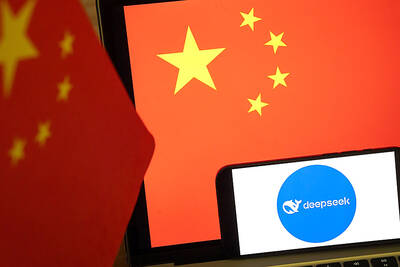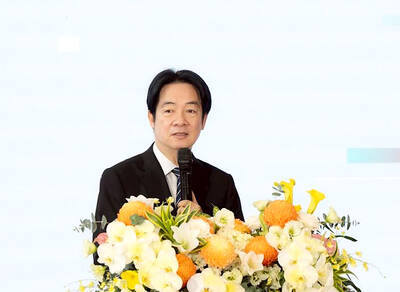Japan, on the eve of a visit by French President Jacques Chirac, said yesterday that the lifting of the EU arms embargo on China being pushed by France would be a "big problem" for Asian stability.
"Considering stability in Asia, the United States and Japan share the awareness that resuming arms exports would be a big problem," Chief Cabinet Secretary Hiroyuki Hosoda, the Japanese government spokesman, told reporters.
Hosoda said the issue of the arms embargo would likely be on the agenda when Chirac meets Prime Minister Junichiro Koizumi tomorrow.
US Secretary of State Condoleezza Rice, on a visit to Tokyo last week, agreed with Japanese Foreign Minister Nobutaka Machimura that the two allies should cooperate to oppose EU moves to lift the embargo.
Chirac said Wednesday he still expected an agreement to lift the ban by the end of June, despite signs the 25-member EU bloc could delay its decision after China authorized the use of force to invade democratic Taiwan.
US lawmakers have threatened to levy punitive trade sanctions on European companies if the EU lifts the embargo, which was imposed after China's bloody crackdown on pro-democracy protests in 1989.
The US has some 47,000 troops in Japan, most of them on Okinawa -- only 550km from Taiwan.
Hosoda said another issue that would be raised in talks with Chirac would be Europe's push to build the world's first nuclear fusion reactor in France despite a rival bid for the project by Tokyo.
A group of lawmakers from Koizumi's ruling Liberal Democratic Party yesterday sent him a petition urging him to be more outspoken on backing Japan's bid for the International Thermonuclear Experimental Reactor (ITER).
"To meet this objective, we would like Prime Minister Koizumi to clearly tell President Chirac our country's position on the ITER during the Japan-France summit," said the petition, according to Kyodo News Agency.
Negotiations are deadlocked with the US and South Korea supporting Japan's offer to build the ITER in Rokkasho, a northern village near the Pacific Ocean, while China and Russia back the EU bid to put it in Cadarache, southern France.
The multibillion-dollar project, which would emulate the sun's nuclear fusion, is designed to one day generate inexhaustible supplies of electricity, but is not expected to be operational before 2050.
Chirac, accompanied by his wife Bernadette and French business leaders, will arrive in the western city of Osaka today to watch sumo wrestling and then head by train to Nagoya to see the World Exposition.
From there he will go to Tokyo tomorrow to meet Koizumi and on Monday he will lunch with Emperor Akihito and Empress Michiko.

MISINFORMATION: The generated content tends to adopt China’s official stance, such as ‘Taiwan is currently governed by the Chinese central government,’ the NSB said Five China-developed artificial intelligence (AI) language models exhibit cybersecurity risks and content biases, an inspection conducted by the National Security Bureau (NSB) showed. The five AI tools are: DeepSeek, Doubao (豆包), Yiyan (文心一言), Tongyi (通義千問) and Yuanbao (騰訊元寶), the bureau said, advising people to remain vigilant to protect personal data privacy and corporate business secrets. The NSB said it, in accordance with the National Intelligence Services Act (國家情報工作法), has reviewed international cybersecurity reports and intelligence, and coordinated with the Ministry of Justice Investigation Bureau and the National Police Agency’s Criminal Investigation Bureau to conduct an inspection of China-made AI language

BOOST IN CONFIDENCE: The sale sends a clear message of support for Taiwan and dispels rumors that US President Donald Trump ‘sold out’ the nation, an expert said The US government on Thursday announced a possible sale to Taiwan of fighter jet parts, which was estimated to cost about US$330 million, in a move that an expert said “sends a clear message of support for Taiwan” amid fears that Washington might be wavering in its attitude toward Taipei. It was the first announcement of an arms sale to Taiwan since US President Donald Trump returned to the White House earlier this year. The proposed package includes non-standard components, spare and repair parts, consumables and accessories, as well repair and return support for the F-16, C-130 and Indigenous Defense Fighter aircraft,

CHECKING BOUNDARIES: China wants to disrupt solidarity among democracies and test their red lines, but it is instead pushing nations to become more united, an expert said The US Department of State on Friday expressed deep concern over a Chinese public security agency’s investigation into Legislator Puma Shen (沈伯洋) for “secession.” “China’s actions threaten free speech and erode norms that have underpinned the cross-strait ‘status quo’ for decades,” a US Department of State spokesperson said. The Chongqing Municipal Public Security Bureau late last month listed Shen as “wanted” and launched an investigation into alleged “secession-related” criminal activities, including his founding of the Kuma Academy, a civil defense organization that prepares people for an invasion by China. The spokesperson said that the US was “deeply concerned” about the bureau investigating Shen

‘TROUBLEMAKER’: Most countries believe that it is China — rather than Taiwan — that is undermining regional peace and stability with its coercive tactics, the president said China should restrain itself and refrain from being a troublemaker that sabotages peace and stability in the Indo-Pacific region, President William Lai (賴清德) said yesterday. Lai made the remarks after China Coast Guard vessels sailed into disputed waters off the Senkaku Islands — known as the Diaoyutai Islands (釣魚台) in Taiwan — following a remark Japanese Prime Minister Sanae Takaichi made regarding Taiwan. Takaichi during a parliamentary session on Nov. 7 said that a “Taiwan contingency” involving a Chinese naval blockade could qualify as a “survival-threatening situation” for Japan, and trigger Tokyo’s deployment of its military for defense. Asked about the escalating tensions